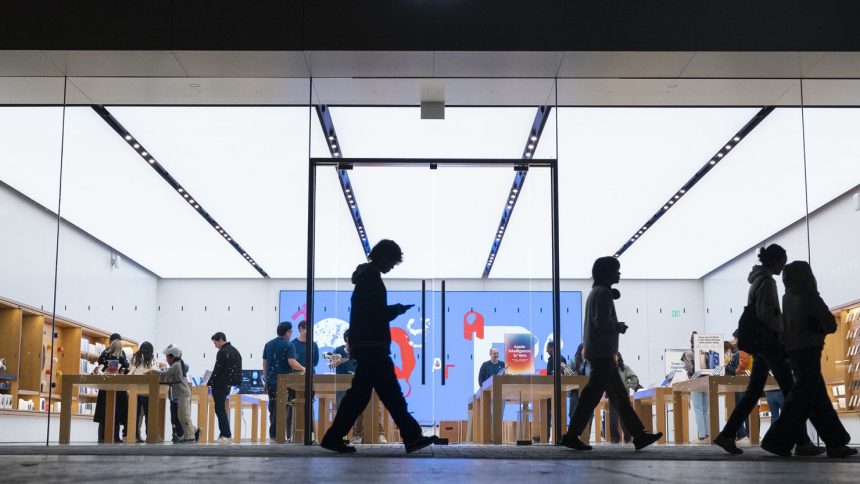New York
CNN
—
Apple’s most profitable product could finally be getting a much-needed change.
The tech giant is soon expected to make its biggest bet in years, introducing a significantly slimmer iPhone to hopefully reinvigorate interest in its biggest revenue driver.
The sleeker new iPhone, sometimes referred to as the iPhone “Slim” or “Air” in media reports, could arrive later this year as part of the iPhone 17 lineup, according to Bloomberg, the Wall Street Journal and The Information. This would be the most notable iPhone design overhaul in years, possibly since Apple launched the home button-free iPhone X in 2017.
But will that be enough?
Apple’s iPhone business is stable; in its first fiscal quarter, revenue from smartphone sales were roughly the same as they were a year ago and the company’s overall revenue grew by 4%. But the product is facing a host of challenges, including consumers holding onto their iPhones for longer, iPhone revenue missing Wall Street’s expectations this past quarter and Apple losing ground in the Chinese smartphone market to regional competitors. Apple needs to figure out how to grow its most valuable business.
Apple did not immediately respond to CNN’s request for comment.
This is not a new story. Apple has long faced pressure to keep evolving and growing its iPhone segment despite challenges like a sluggish smartphone market and tough competition in China.
This time, however, Apple’s big bet on artificial intelligence – which it’s been marketing as a selling point for the iPhone 16 – is taking longer than expected to pay off. In the meantime, Apple may have to rely on its physical devices to wow consumers.
“I think there’s more pressure on Apple than there has ever been since Samsung was taking market share” on the strength of its larger displays, said Patrick Moorhead, CEO and chief analyst at tech advisory firm Moor Insights & Strategy.
The thinner iPhone 17 expected to arrive this year will be about two millimeters slimmer than the current iPhone, according to Bloomberg. It will likely replace the iPhone Plus, the larger version of the base model, in Apple’s smartphone lineup. The phone’s skinnier build is expected to be its main draw; it’ll otherwise share many traits with current iPhones, such as the dedicated camera button and Dynamic Island cutout near the top of the screen, according to Bloomberg’s report.
A move like this could be particularly appealing in China, where product design is a high priority for consumers, said Nabila Popal, a senior director for market research firm the International Data Corporation’s data and analytics team.
Chinese appeal is critical because Apple’s China revenue shrunk in its first fiscal quarter of the year: $18.5 billion from $21 billion a year ago. Fourth-quarter sales of the iPhone in China fell 25% year-over-year thanks to increased competition from Chinese brands, according to market research firm Canalys. Chinese tech giant Xiaomi surpassed Apple to become the worlds second largest smartphone brand in August, Counterpoint Research, another firm that follows the smartphone market, reported in September.

“Hardware innovations are very important to Chinese consumers,” said Popal, who specializes in researching smartphones and consumer tech devices. “And given how well thinness has done with Android models, I think that launching such a device for Apple could help its share” in China.
The company’s rivals have already beaten Apple to the punch. Samsung in January announced the Galaxy S25 Edge, a sleeker version of its latest smartphone. Oppo, a major player in the Chinese phone market, debuted a super thin version of its foldable phone called the Find N5 in February.
But some analysts say it’s going to take more than just a flashy new design to entice shoppers. Apple needs to convince consumers to want a new iPhone, whether their old one needs replacing or not.
Smartphones are mature devices; they no longer change much each year, unlike in the early 2010s when buying a new model meant unlocking your phone with your fingerprint for the first time or fitting a much larger screen in your pocket. In a March 25 note, UBS analysts wrote that the average iPhone user (in markets other than China) keeps their phones for longer: 37 months, compared to roughly 34 months in its survey from last year.
Apple Intelligence, the name for Apple’s AI-powered software, could be the key to changing that. But the currently available tools aren’t exactly upgrade-worthy. (Think: summarizing notifications, generating custom emojis and asking Siri for tech support.)
Apple also recently said its arguably biggest new capability coming in Apple Intelligence, a revamped Siri, has been delayed. Instead of setting alarms and answering questions, the new Siri should be able to take actions in apps on a user’s behalf and incorporate data stored on a person’s iPhone into responses. These are changes that Apple believes could alter the way we use our phones and interact with apps.
But consumers are going to have to wait longer to try it. Apple says it’s expected to debut in the coming year.
Apple will likely provide a glimpse at what’s next for Apple Intelligence during its Worldwide Developers Conference keynote, which the company announced this week will take place on June 9.
Apple’s upcoming announcements – and whether it can deliver on those promises – could help show whether AI will be useful enough to get iPhone users to shell out for an upgrade.
Apple needs something big – and maybe that means going thinner. Wall Street will be watching to see whether smarter software or a sleeker design will do the trick.
“If you have an (iPhone)14, or even if you have a 15, there’s probably no economic reason to justify upgrading right now,” said David Vogt, an analyst with UBS. “And I think that’s the pressure that Apple feels.”


